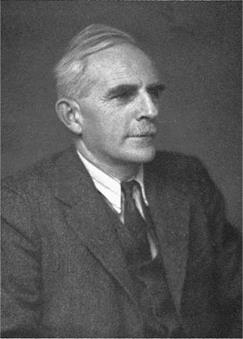S. B. Gates in Britain
Sidney Barrington (Barry) Gates had a remarkable career as an airplane stability and control expert in Britain, spanning both World Wars. He left Cambridge University in 1914, in his words, “as an illegitimate member of the Public Schools Battalion of the Royal Fusiliers.” Somebody with unusual perception for those days saw that the young mathematician belonged instead in the Royal Aircraft Factory, the predecessor of the Royal Aircraft Establishment or RAE, and he was transferred there.
|
Figure 3.10 Sidney B. Gates (1893-1973), contributor to understanding of airplane spins; originator of neutral and maneuver points, stick force per g, and many other flying qualities matters. (From Thomas and Kiichemann, Biographical Memoirs of Fellows of the Royal Society, 1974) |
Gates remained at the RAE and as a committee member of the Aeronautical Research Council until his retirement in 1972. His total output of papers came to 130, a large proportion of which dealt with airplane stability and control. His approach to the subject is described by H. H. B. M. Thomas and D. Kuchemann in a biographical memoir (1974), as follows:
Gates’s life-long quest – how to carve a way through the inevitably harsh and complex mathematics of airplane motion to the shelter of some elegantly simple design criterion based often on some penetrating simplification of the problem.
This approach is seen at its best in his origination of the airplane static and maneuver margins, simple parameters that predict many aspects of longitudinal behavior. He gave the name “aerodynamic center” to the point on the wing chord, approximately 1 /4 chord from the leading edge, where the wing pitching moment is independent of the angle of attack. The wing aerodynamic center concept led to current methods of longitudinal stability analysis, replacing wing center of pressure location.
Gates is also remembered for a long series of studies on airplane spinning, begun with “The Spinning of Aeroplanes” (1926), co-authored with L. W. Bryant. Gates’ other airplane stability and control contributions over his career cover almost the entire field. They include work in parameter estimation, swept wings, VTOL transition, flying qualities requirements, handling characteristics below minimum drag speed, transonic effects, control surface distortion, control friction, spring tabs, lateral control, landing flap effects, and automatic control.
Together with Morien Morgan, in 1942 Gatesmade a two-month tour of the United States, “carrying a whole sackload of RAE reports on the handling characteristics of fighters and bombers.” The pair met with the main U. S. aerodynamics researchers and designers at the time, including Hartley Soule, Gus Crowley, Floyd Thompson, Eastman Jacobs, Robert Gilruth, Hugh Dryden, Courtland Perkins, Walter Diehl, Jack Northrop, Edgar Schmued, W. Bailey Oswald, George Schairer, Kelly Johnson, Theodore von Karman, and Clark Millikan. As Morgan comments, the scope and scale of the 1942 “dash around America” showed what a towering reputation Gates had worldwide.















